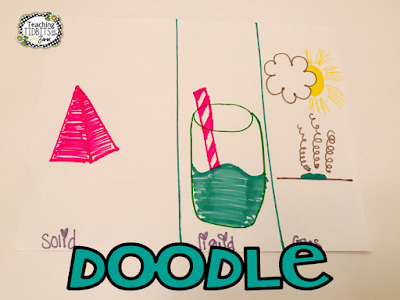
Are you using formative assessments in your classroom? We all use summative assessments in our class in some form or another. Summative assessment is used after a unit or time of period to assess how much learning has taken place. We use summative assessments after a chapter or topic has been taught. We use them on our weekly test. But how much FORMATIVE ASSESSMENTS are you using in your classroom?
Most of us use some form of formative assessments without realizing we are even doing it. When we walk around our classroom and monitor learning, when we ask our students higher order questions, or when we have students to give us an explanation to their learning. All of these are types of formative assessments. However, we must ask ourselves as educators is there more we could do to assess the learning taking place in our classroom?
What are Formative Assessments
Formative assessments are different in that they are taking place during learning and do not need to be graded. Formative assessments are used to check for understanding along the way during teaching. They can be used in all content area, such as formative assessments in reading. Teachers and students can use formative assessments. They help us as teachers to see if we need to reteach a lesson. Also, it helps us to see which learners in our class are grasping the concepts being taught and which are not.
With the ever growing list of things a teacher has to do, formative assessments should not consume much time. Formative assessments in the classroom should not cause a burden on the teacher or the student. Formative assessments should be a quick and simple check that is:
-
-
- Engaging
- Meaningful
- Provides Feedback to Both Teacher and Student
-
So, what are some different ways you can provide engaging and meaningful formative assessments in your classroom? Below are a list of my favorite formative assessments to use in my class.
Exit Cards
I have seen a variety of ways to present exit cards and heard them called different names, such as exit tickets. However, they all have the same purpose. The teacher poses a question, the student answers, and gives to the teacher when leaving the room. Exit tickets can be posted on the door, slipped into a box, written on an index card, or many other ideas. The teacher then quickly glances through the answers and sorts the results into two piles. The tickets are based on students who understood and students who need more instruction.
In the image below I posed the question 300-129 to my class. I wanted to check their regrouping skills. The exit ticket allowed me to clearly see where each child was messing up and where they were performing the skill correctly. I love to use this formative assessment in math.
Checklist
A checklist works by a teacher walking around the room while students are either working independently or in groups and marks on a clipboard a simple check by each students name. They put a check in the column for yes if the student seems to have grasp the concept, or put a check in the no column in they need further instruction.
Beach Ball Throw
Students love this activity and it gets the kids moving. You purchase a cheap beach ball at your local party store and write questions on the ball. Toss the ball to a student. Wherever their right hand lands, they answer the question about their learning. Then, they toss to another student in the class. This continues until everyone has had a turn. This is a great way to get in formative assessments for reading.
Idea Graffiti
Students are placed into groups of 4-5. Each group is given a piece of butcher paper. Each student is given a different colored marker. They write a complete sentence about something they learned during the lesson. The different colored markers help identify the students in each group without using names.
The image below shows how my students use the formative assessment of Idea Graffiti when responding to the novel, The War that Saved My Life.
Yes or No Formative Assessments
This is just putting a spin on thumbs up or thumbs down. Glue yes and no on popsicle sticks. Have a series of questions ready to ask that pertain to the lesson. The students will hold up yes or no to answer the question. Also, if you prefer you could glue true or false. If this is too time consuming to make, white boards would work just as well.
Four Corners
Assign each corner of the room either A, B, C, D. Ask a question with four possible answers. Students then move to the corner they believe to be the correct answer. This is not only a great formative assessment, but works as a brain break too!
Roll the Die
Each student is given a number cube. They roll the die. Based on the number they land on students write their response on a sticky note or index card and turn in when leaving the room. Student responses are based on the following rolls:
1: Write a question that someone should be able to answer after this lesson. Give the answer to the question.
2: Explain the lesson so a preschooler could understand.
3: Draw a picture to represent the main idea of the lesson.
4: List three things that you learned today about this topic.
5: What was the most interesting thing you learned to today?
6: Tell which part was the most confusing. Why?
Doodle
Students will quickly draw a picture of the topic learned instead of writing in words.
Kahoot
This is a great tool to use for all you technology lovers! It provides instant feedback and the students love it! You will need iPads, Chromebooks, or some form of mobile devices for the students to use. The teacher poses a question and the student answers. Kahoot will provide immediate feedback to show who is on track. Don’t worry if your not a 1:1 classroom. For example, I currently have 6 iPads. I place my class into groups of 6, and they rotate the iPad around within their group. Instead of having names listed in Kahoot, I list it as “Groups”. Kahoot is great to use for formative assessments in reading or math.
Plickers
Plickers is a great tool to use for formative assessments in the classroom. What is even better, only the teacher is using the technology. Only the teacher is required to have technology. Ahead of time print a QR code for each child. When you are ready ask your question the kids hold up their assigned QR code. You use your device and hold it up to scan their codes. Just like Kahoot, Plickers will provide instant feedback too! The kids love this formative assessment tool!
There you have it some of my favorite forms of formative assessments to use in the classroom. I hope you found something you can use in your classroom that will help you assess your students learning along the way. Remember we want to work smarter, not harder! Formative assessments should not be more work for you, but something you can easily fit into your lesson. I would love to hear from you. If you have any other neat formative assessment ideas you are using in your classroom please leave a comment below! Thanks for stopping by and taking a peek!
















